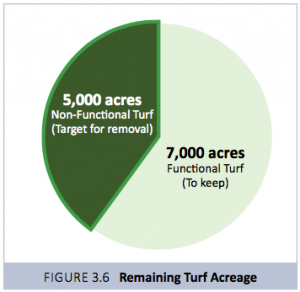
Is there such a thing as “useless” grass? Officials from the Southern Nevada Water Authority (SNWA), which serves a drought–prone area, think there is. On April 5, SNWA lobbyist Andy Belanger asked lawmakers from the Las Vegas Assembly Committee on Natural Resources to mandate the removal of “unused” turf by the end of 2026. Within a few days, headlines across the country reported the shocking news: Las Vegas seeks to ban ornamental grass.
The proposed idea on phasing out certain categories of grass permanently would reportedly be the first law of its kind in the country. “The scale of this is pretty unprecedented in terms of a full ban on this nonfunctional turf,” John Berggren, a water policy analyst at Western Resource Advocates, told the Associated Press (AP). But it also isn’t quite as draconian as it might initially appear. Justin Jones, a Clark County commissioner who serves on the water authority’s board, also commented to the AP, “To be clear, we are not coming after your average homeowner’s backyard.” But grass in the middle of a parkway, where no one walks: “That’s dumb.”
Current Conservation Measures
According to the SNWA, the Las Vegas Valley gets about 90% of its water from the Colorado River, which is facing the worst drought in the river basin’s recorded history due to below average snowfall (and subsequent runoff) for several years. The water level of Lake Mead, one of the River’s primary water storage reservoirs and the source of most of the area’s drinking water, is more than three trillion gallons below capacity and has dropped more than 130’ since January 2000.
As a result, intense water conservation strategies are not new to the transformed desert landscape of Las Vegas. Existing city turf limits already include:
- No new turf allowed in front yards of single family homes. 50% of side and rear yards or 100 square feet, whichever is greater, may be grass (maximum of 5,000 square feet).
- Turf is prohibited in common areas or front yards of multi-family units like condos or apartments, except for privately-owned parks with an area greater than 10’.
- New turf is prohibited in non-residential development, with the exception of schools, parks, or cemeteries, or by special permit.
- Golf courses are limited to five acres average per hole, with a maximum 10 additional acres for driving ranges.
- Parks and community-use recreational turf areas have no turf area restrictions but must comply with specific watering regulations.
Measures likes this and others adopted in 2003 have reduced water consumption by 52% in 2019, despite population growth of 730,000 residents.
Tougher Times Ahead
But tougher times may lie ahead. The federal government is projecting a high probability that Lake Mead water levels may fall below 1,075’ in 2021, possibly reducing the amount of water available to Nevada, according to SNWA. And the AP reports that voluntary conservation efforts are slowing, despite a generous rebate policy of up to $3 a square foot to tear out sod.

In response, the SNWA has set its sights on the elimination of “nonfunctional turf” by 50% by 2035, as outlined by the Authority’s 2020 Integrated Resource Planning Advisory Committee (IRPAC) recommendations. The agency estimates that more than 5,000 acres of such turf — grass not used for recreational activities or even walked on— is currently spread throughout the region, mostly in street medians, common areas, and commercial frontage. Achieving the 2035 target, asserts the IRPAC report, could save 365 million gallons of water annually.
“No one plays on this grass. No one walks on this grass — except the landscaper who sometimes has to carry equipment across lanes of traffic to mow it. It is purely for show, and it is a luxury our community can no longer afford,” Belanger told members of the Assembly Committee on Natural Resources, as reported by the AP.
Not only is the function of the turf being examined, but the type of turf. Besides eliminating non-functional turf, another IRPAC goal is limiting future installations of cool-season turf in public spaces and converting cool-season turf to warm-season turf at existing public parks and facilities. The SNWA says the estimated water savings is 21 gallons per square foot of turf converted, and they are working to identify conversion opportunities and provide incentive programs. Future efforts to limit new cool-season turf installations may include changes to service rules, codes, and ordinances.
While some laud the turf proposals as necessary and precedent setting in era of climate change, others point out the many benefits of grass to combating urban heat island effects and more. For landscapers in Las Vegas, the turf measures would mean more regulations and decidedly less mowing and turf care contracts, but it might also mean more work in turf conversions and ongoing maintenance. The Las Vegas area already offers incentives for turf conversion and smart irrigation. And the SNWA promotes a Water Smart Contractor designation for landscapers who complete at least eight hours of SNWA water-efficiency training. It even includes a link to “Find a Landscaper” on its homepage. The landscaper of the future, particularly in Las Vegas, may indeed find water conservation expert increasingly added to his/her list of qualifications.
For the full April 12 AP article by Sam Metz and Kevin Ritter, “Water-worried Vegas wants useless grass a thing of the past,” click here.
TOP PHOTO: ISTOCK/mikkelwilliam
Are you a landscaper in Las Vegas or a similarly drought-challenged area? How do you feel about proposed measures such a this? Does it stimulate the landscaping business or hinder it with regulation? Make your voice heard in the Comments.











![[VIDEO] Dickies®: Discover Workwear That’s Anything But Uniform](https://turfmagazine.com/wp-content/uploads/2023/06/1647663814-4b1a2a7742790a9b1e97a3b963477850192e1d6a9dfba9b07214a77bae25d6e3-d-218x150.jpg)





























![[VIDEO] Dickies®: Discover Workwear That’s Anything But Uniform](https://turfmagazine.com/wp-content/uploads/2023/06/1647663814-4b1a2a7742790a9b1e97a3b963477850192e1d6a9dfba9b07214a77bae25d6e3-d-324x160.jpg)